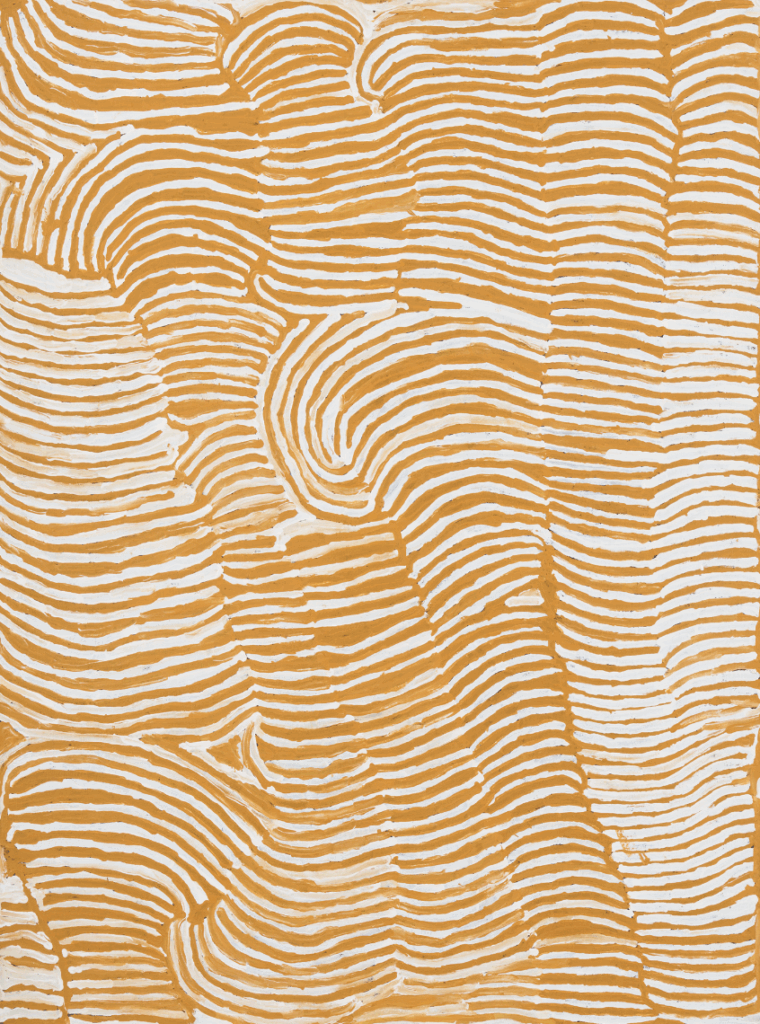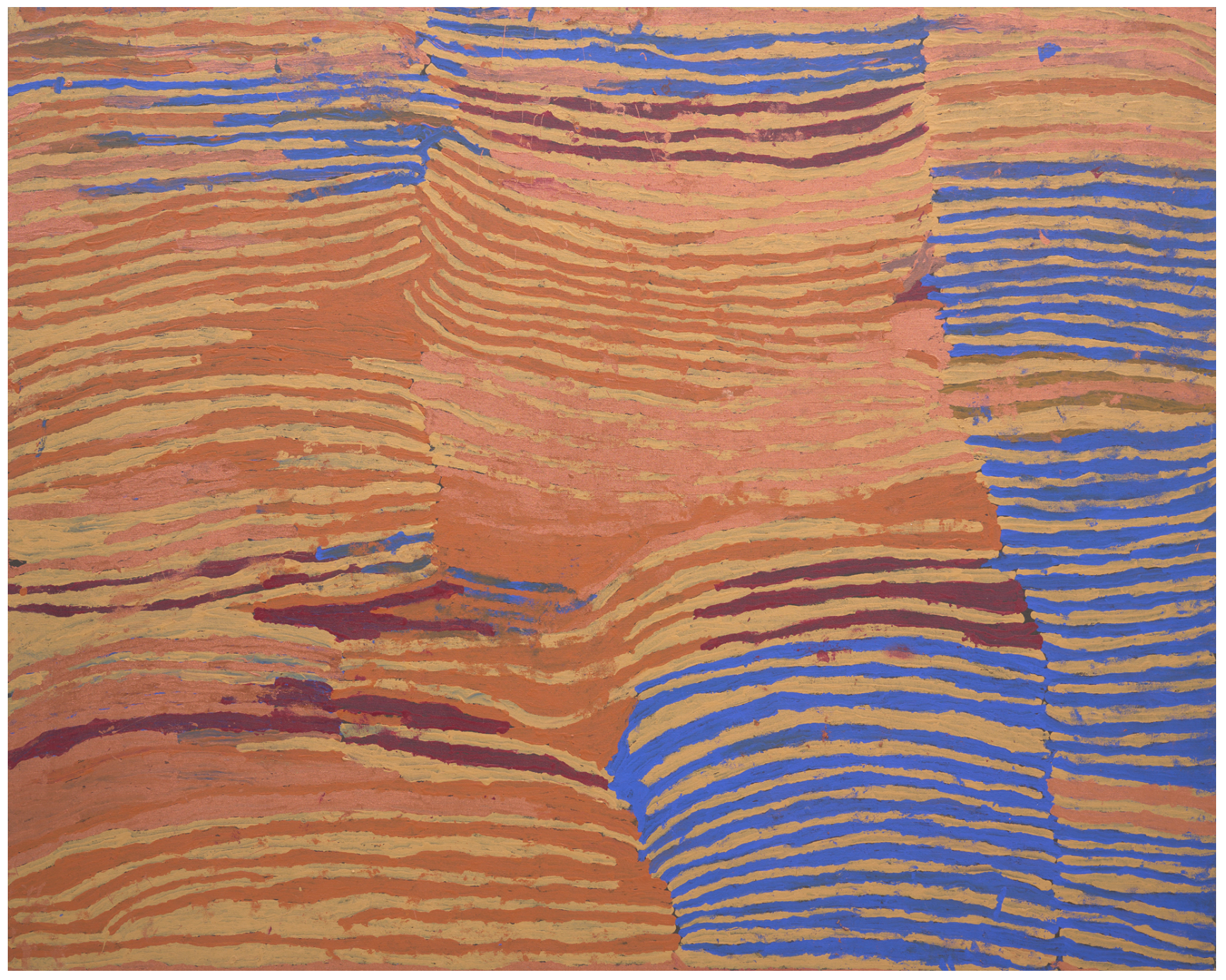Makinti Napanangka (c.1930–2011) stands among the most influential painters of the Western Desert movement and the Papunya Tula Artists cooperative. A senior Pintupi woman, she was central to the mid-1990s surge of women artist’s painting from Kintore and Kiwirrkura; momentum catalysed by the Haasts Bluff and Kintore women’s collaborative painting project of 1994. This significant project which included a series of major paintings that were exhibited at the Tandanya National Aboriginal Cultural Institute in Adelaide, represents the beginning of Pintupi women’s participation as independent artists in the Western Desert art movement.1
Makinti’s practice, grounded in ceremonial design and Women’s Law, redirected awareness to the aesthetics and authority of Pintupi women’s cultural narratives within Papunya Tula. Makinti refined a pictorial language that conveyed ceremonial motion as rhythm and colour, layering the canvases with paint, creating a sense of movement. This painting style is a contrast to the detailed and precise dotting that is typical of men’s traditional painting of Dreaming Law.
Makinti’s paintings centre on two related Dreamtime stories, the journeys of Kungka Kutjarra, the two ancestral women, and the rockhole site of Lupulnga, South of Kintore. The Kungka Kutjarra story is the focus for the 2001 artwork in our upcoming October Fine Art Auction. This work is rich in colour and texture; the pale swirling lines represent the handspan hair string skirts worn by women in ceremonial dance. These skirts, woven from human hair and spindle sticks, animate the canvas with looping banded forms applied over the orange ochre toned background. Makinti’s approach to painting is looser and more gestural than many of her contemporaries, offering a tactile and sensual experience that is immediate and energetic. The emphasis is on movement and cultural presence, differing to the precision of the dot work and geometric lines seen in traditional men’s paintings.

© Makinti Napanangka/Copyright Agency, 2025
The Kungka Kutjarra narrative is significant to Makinti’s oeuvre, often entwined with sites around Lake MacDonald (Kaakuratintja) and the ceremonial rockhole of Lupulnga, over which she held custodial rights. Her paintings from the late 1990s through to the 2000s, pursue this story with increasing visual confidence. The concentric rockhole motifs from earlier works, give way to expanses of undulating lines, representing the string of the skirts worn in ceremonial dance. These flowing lines, which appear to extend beyond the edges of the canvas, create a sense of dynamism, emulating the movement of the dance. This repeated thematic focus, anchored in knowledge of the place and performed ritual, is central to Makinti’s authority as a cultural custodian, as well as to the artwork’s visual power.
In the early 2000s, Makinti began to experience greater recognition for her innovative and energetic artworks. In 2000, one of her works was included in the major retrospective exhibition ‘Papunya Tula: Genesis and Genius’ at the Art Gallery of New South Wales, Sydney, and in 2003, in the Clemenger Contemporary Art Award at the National Gallery of Victoria. In 2008, Makinti won the National Aboriginal and Torres Strait Islander Art Award with an untitled painting of Lupulnga which was an acknowledgement of both artistic achievement and cultural leadership. The career defining prize helped spotlight Papunya Tula women artists within national narratives of contemporary art, not merely as an adjunct to the creation stories of men.
The growing attention to Papunya Tula women artists over the past few decades is visible in exhibition programming and secondary market activity. Institutional and commercial art shows continue to spotlight Pintupi women’s painting as an evolving intergenerational practice; recent exhibitions have explicitly named these women as a ‘next generation’ which builds on the legacies of artists such as Makinti Napanangka and Wintjiya Napaltjarri. Meanwhile, auction results for key Kungka Kutjarra and Lupulnga works by Makinti from the early 2000s, demonstrate steady demand. These curatorial and commercial trends, reflect a broader reassessment of women’s contributions to Papunya Tula’s history and its present.
Artworks such as Untitled – The Travels of Kungka Kutjarra (Two Women), embody Makinti Napanangka’s synthesis of ceremonial design, narrative and a distinctive painterly language. The sweeping lines of the hair string forms in the painting do more than describe ceremonial adornment; they enact movement, combining place, ancestry and performance within a single canvas. In doing so, the artwork, like Makinti’s practice at large, illustrates why the paintings of Papunya Tula women artists have become a locus of sustained scholarly, curatorial and collector interest.
The Fine Art auction will take place on Tuesday 21 October 2025 in Melbourne. For viewing times and to the full catalogue please visit our website.
By Amanda North, Senior Fine Art Specialist
Top Image: Makinti Napanangka (c.1930-2011) Untitled 2004, synthetic polymer paint and enamel on linen, 121 x 153cm. Sold for $32,500. © Makinti Napanangka/Copyright Agency, 2025
October – November
